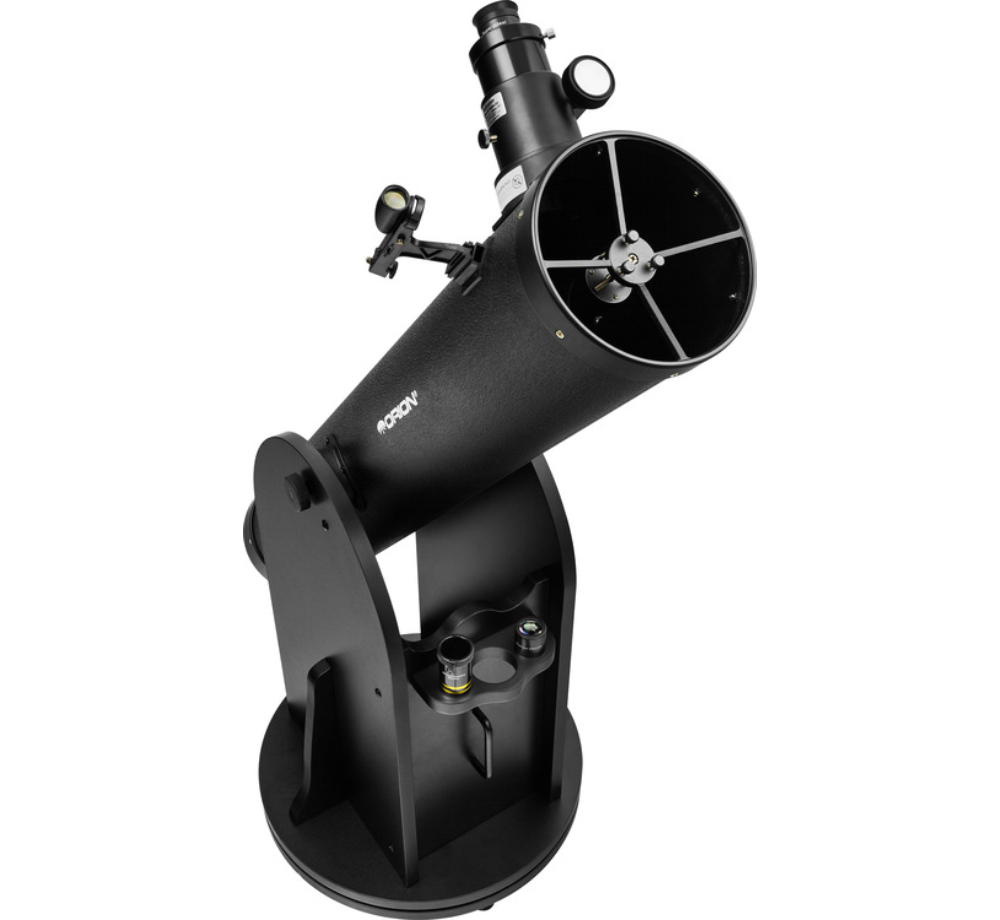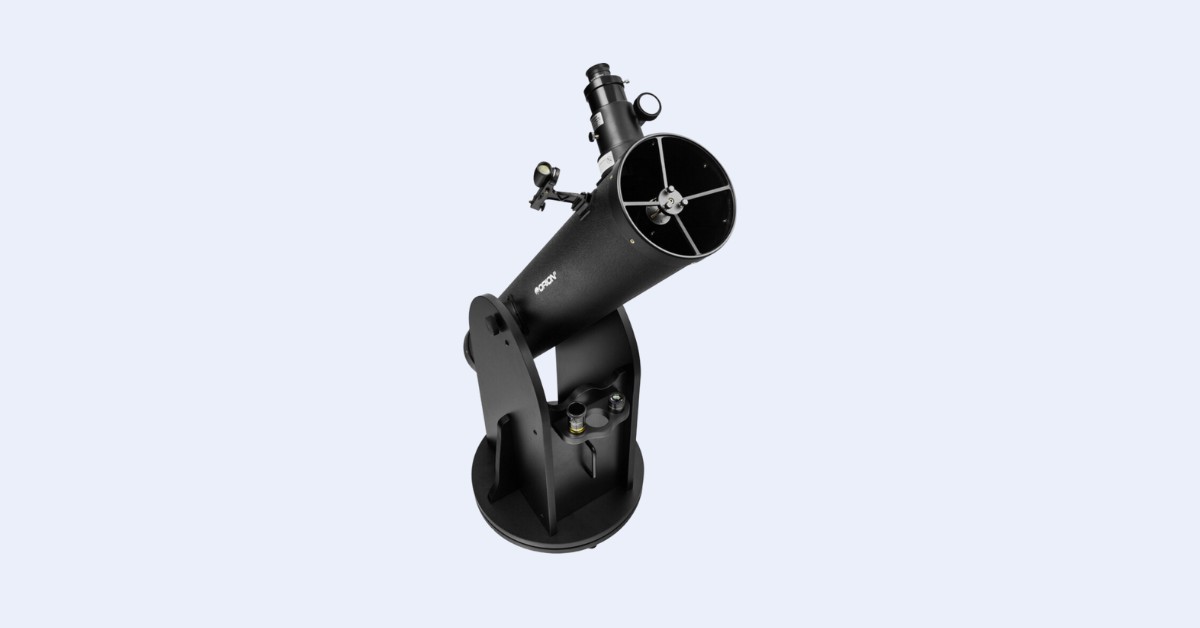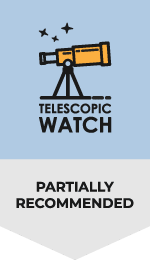The Optical Tube
The Orion SkyScanner BL135 is a 135mm (5.3”) f/8.1 Newtonian reflector with a resulting focal length of 1100mm. The primary mirror in this telescope is spherical. At this size and focal ratio, the curvature difference between spherical and parabolic mirrors is just small enough that the BL135 fits within the tolerances of what is considered acceptable for a parabolic mirror, albeit barely. The scope handles up to 250x magnification just fine and has sharp views, though the quality control coming from KSON is definitely questionable and may not always result in you getting a scope with a tested and well-figured (albeit still spherical) optic. The primary mirror can be collimated without tools, and the secondary mirror uses Philips head screws for easy adjustment.

The SkyScanner BL135 uses a massive, 2” rack-and-pinion focuser (probably repurposed from another telescope design) with a mix of plastic and metal components. But it only works with 1.25″ eyepieces, and because of its height, the SkyScanner BL135 has to use an unusually large 1.6″ secondary mirror to avoid vignetting. This results in some contrast loss because of the extra obstruction. The provided focuser works okay, though it looks ridiculous.
Accessories
The SkyScanner BL135 comes with two 1.25” eyepieces: a 25mm Kellner providing 44x magnification and a 10mm Plossl providing 110x. The 25mm Kellner is alright, but the apparent field is rather narrow (under 50 degrees), and it suffers from glare and ghost images, as well as a lack of any kind of rubber eyeguard. The provided 10mm “Super plossl” (missing the correct punctuation on the label) is almost unusable; the eye relief is so short that it is nearly impossible to take in the whole (narrow) field of view, and it suffers from the glare and ghost image problems of the 25mm Kellner, alongside unusually dim images.
The SkyScanner BL135 also includes a “3x Achromatic Barlow lens” which uses a single plastic lens element in a plastic body. It’s similar to what’s provided with low-quality beginner telescopes like the Celestron PowerSeeker line and provides too much magnification (330x with the 10mm Plossl) to be of any use anyway, along with, of course, an unusably fuzzy image with any eyepiece filled with glare and rainbows of chromatic aberration around bright objects.
The SkyScanner BL135 comes with an unusually low-quality red dot finder. The viewing window is tinted gray, it’s hard to align with the telescope and doesn’t stay aligned, and the power switch and adjustments are very tiny and hard to adjust. Using the red dot finder that comes with the telescope to aim it is, well, frustrating. Thankfully, a standard red dot finder of superior quality will slide right on in its place using the provided rail.
Orion includes a decent printed moon map with the SkyScanner BL135, but many people probably prefer a digital map anyway, or you could print your own for free.
Mount
The SkyScanner BL135 uses a Dobsonian mount constructed entirely out of ¾” particle board. It is extremely sturdy but unusually heavy at 24 lbs (10.9 kg) by itself, heavier than the base provided with a typical 10” Dobsonian like the Apertura AD10, Orion’s own XT10, or Skyline 10. There is absolutely zero weight optimization going on here to speak of. The telescope pivots up and down with circular bearings gliding on plastic cylinders and left to right on plastic pads gliding against the melamine-coated surface of the base.
The SkyScanner BL135’s altitude bearings are absolutely tiny, and are tensioned with a pair of clutches to adjust friction. With even a slightly heavy accessory mounted in the focuser or attached to the tube (such as a nice eyepiece or magnifying finder) the telescope becomes top heavy and you have no choice but to tighten the clutches to prevent it from aiming downward. This issue exists on Dobsonians offered by Orion in their Intelliscope and former XT Plus series, as well as the Dobsonians offered by Sky-Watcher and Celestron, but those telescopes all have significantly larger altitude bearings than the SkyScanner BL135’s, with a minimum size of about 5”, and thus there is at least some tolerance for imbalance. The Orion SkyScanner BL135’s altitude bearings are less than 3” (76mm) in diameter. To avoid upsetting the balance of the telescope, you must use only a red dot finder and avoid using heavy eyepieces or Barlow lenses.
Should I buy a Used Orion SkyScanner BL135?
I wouldn’t recommend a used SkyScanner BL135 unless it’s available for a substantially lower price than a 130mm tabletop Dobsonian or a similarly higher-quality scope of the same aperture. When considering a used one, be sure that the particle board base has no obvious damage and the coatings on the mirrors are corroded (normally we’d say to check for missing accessories, but the provided ones are bad enough that they won’t be missed).
Alternative Recommendations
The SkyScanner BL135 is far from our top pick in its price range. In its place, we recommend the following alternatives.
Under $350
- The Sky-Watcher Heritage 150P offers more aperture than the SkyScanner BL135 with quality accessories and a compact, tabletop package, with parabolic primary mirror optics and a short 750mm focal length for a wider field of view.
- The Sky-Watcher Heritage 130P offers the same features as the larger 150P but with smaller aperture and an even lower price tag, with performance that is on par with the SkyScanner BL135 – though the Heritage 130P can achieve a much wider field of view on account of its 650mm focal length.
$350-$500
- The Sky-Watcher Virtuoso GTi 150P is basically identical to the manual Heritage 150P model, but has fully motorized tracking and GoTo controlled from your smartphone, allowing it to automatically locate and track targets at your leisure. It can also be aimed manually without affecting the alignment of the GoTo system on the sky. A 130mm version is also available, though we’d recommend you stick with the 150mm Virtuoso GTi or Heritage due to its greater capabilities.
$500-$700
- The Apertura AD8/Zhumell Z8/Orion SkyLine 8 offers dramatically more capability (2.5x as much light gathering and 50% more resolution) than the SkyScanner BL135 thanks to its larger aperture, high-quality focuser, and well-made included accessories
- The Explore Scientific 10” Hybrid Dobsonian has a primary mirror nearly double the size of the SkyScanner BL135’s, offering nearly quadruple the light gathering ability and double the resolving power, along with an extremely well-designed structure, though it needs additional accessories to perform well.
Aftermarket Accessory Recommendations
I believe upgrading the accessories is certainly worthwhile if one is committed to the SkyScanner BL135. A 32mm Plossl eyepiece provides 34x magnification and a true field of 1.5 degrees across, wider than that of the included 25mm Kellner and with fewer glare and sharpness issues. A 15mm redline eyepiece provides 73x, ideal for lunar observing and medium-sized deep-sky objects, and a 6mm “goldline” or “redline” boosts magnification to 183x, nearing the limit of what the SkyScanner BL135’s optics can handle but great for lunar, planetary, and double star observing. If 183x sounds like too much, a 9mm redline will give you 122x.
A standard red dot finder without the issues that plague the stock unit provided with the BL135 is inexpensive, slides right onto the rail provided for attaching the original, and will greatly ease your frustrations in aiming the telescope.
Despite its high cost, a UHC (ultra high contrast) nebula filter like the Orion 1.25” UltraBlock filter will greatly boost your views of nebulae whether you live in a light-polluted location or are fortunate to have access to dark skies, increasing the contrast between the nebula and the background sky – though it will not help with other deep-sky objects like star clusters and galaxies.
What can you see with Orion SkyScanner BL135?
The SkyScanner BL135 has enough aperture to permit decent deep-sky views. Even if you live in a place with a lot of light pollution, open star clusters like the Double Cluster, M11, M35, and the famous Pleiades (M45) will dazzle you with their many bright and colorful stars. Some open clusters show hundreds of stars within them, and there are hundreds of individual clusters that can be seen with a 5” telescope under dark skies at any time of year. Globular star clusters, such as M3, M13, M15, and M22, can also be resolved at high magnification (albeit with a better eyepiece than the provided 10mm Plossl) under suburban or better skies with the SkyScanner BL135 and show their individual stellar members, though dimmer globular clusters will still appear as faint smudges if they are even visible at all.
Dark skies are required for much galaxies observation; light pollution will only allow you to see the brightest ones, such as Andromeda (M31), and without much detail through any telescope. A filter doesn’t help. Under dark skies, however, you can see dust lanes in galaxies like M31, M82, and M104 with the SkyScanner BL135, and galaxy groups like the Leo Triplet, along with the huge Virgo Cluster, can be seen, with the latter showing dozens of galaxies – albeit most without any hints of detail, owing to their elliptical structures. Under dark skies, the SkyScanner BL135 should be able to see at least a few hundred galaxies.
Nebulae look great with the SkyScanner BL135 too, especially with dark skies and/or a UHC nebula filter. The Orion Nebula (M42) dazzles with its dark lanes, bright clouds of gas, and the Trapezium cluster at its center, as does the similar Lagoon Nebula (M8). The Swan (M17) shows looping tendrils of gas, particularly with a UHC filter. You can also see the smaller Trifid (M20) and faint Eagle (M16). The faint Veil supernova remnant is within reach with a UHC filter. Large planetary nebulae like the Helix and the Dumbbell (M27) are conspicuous even at low power, and a UHC filter brings out more detail, while smaller ones like the Ring (M57) are best with high magnification and unfiltered, as well as being less affected by light pollution than larger targets.
The SkyScanner BL135 works pretty well on Solar System objects, too. Expect to see the phases of Mercury and Venus, along with polar ice caps and dust storms on Mars. When Mars is at its closest to Earth, high magnification with the SkyScanner BL135 may bring out a few dark markings on its surface under steady seeing conditions. The Moon delights with thousands and thousands of craters, ridges, mountain peaks, and other details visible down to a limit of a handful of miles across under almost any conditions and regardless of phase. You can also easily see the moons of Jupiter, along with their disks and inky black shadows when they transit in front of Jupiter every so often. Jupiter itself boasts an array of colorful and ever-changing cloud belts, storms, and of course the Great Red Spot, which can be seen on a good night at high magnification.
Saturn’s rings look lovely with the SkyScanner BL135, and the telescope has sufficiently good optics to reveal the Cassini Division within the rings on a clear and steady night, along with Saturn’s dull cloud bands and a handful of moons circling the planet. Uranus and Neptune don’t look like much – you should be able to perceive Uranus’ teal-green disk at high magnification, though Neptune’s may be more difficult to distinguish from a star, especially on a more turbulent night. Uranus’ moons as well as Pluto are simply too faint to see with a telescope under 8-10” in aperture, but the SkyScanner BL135 has just enough light-gathering capability to show you Neptune’s only large moon, Triton, under dark, steady skies with high magnification.



